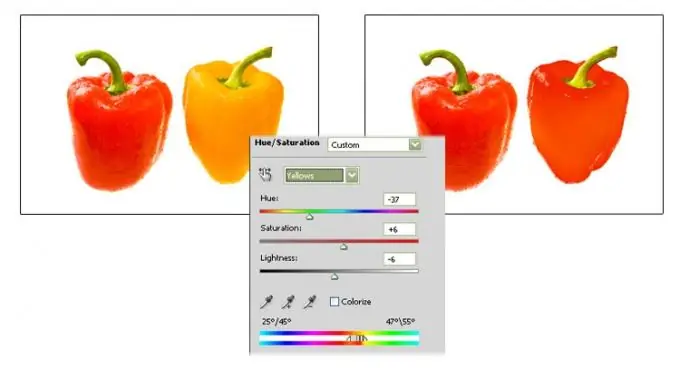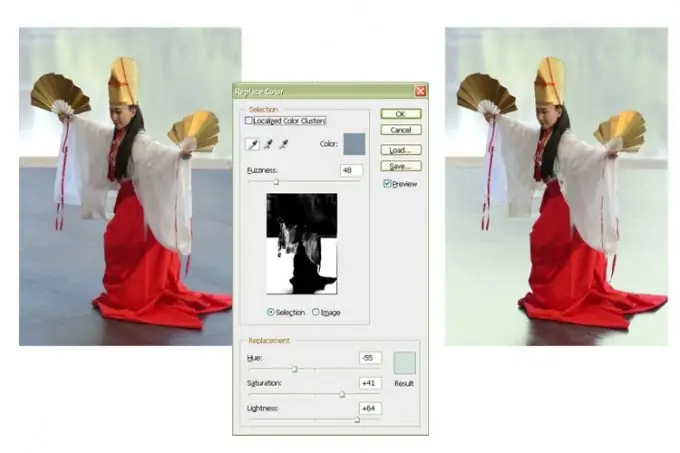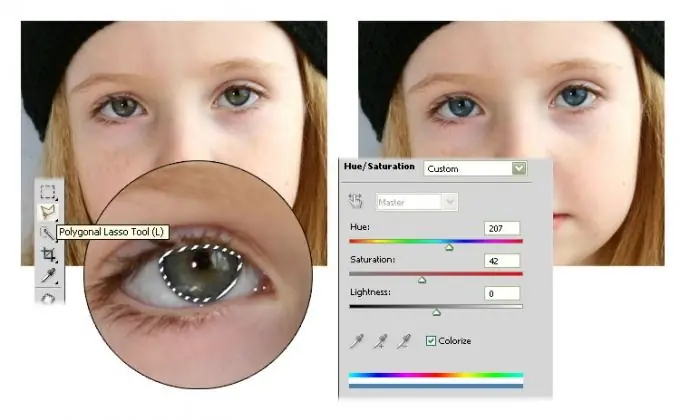One of the most necessary operations in the course of image processing is changing or correcting the color of an object or picture as a whole. Adobe Photoshop is a universal designer's tool that includes many tools that allow you to perform this operation in the most convenient and fast way.

Instructions
Step 1
The color change operation is technologically divided into two stages:
- first of all, it is necessary in one way or another to highlight that part of the image that will be subject to color correction, - secondly, it is, in fact, the very operation of changing the color characteristics of the selected fragment.
In the arsenal of the Adobe Photoshop program there are more than a dozen different tools with which you can influence the color of the image in one way or another. Some of them have a built-in system for automatic selection of the zone of influence, while the use of others implies that a fragment has already been selected in advance.
It is often necessary to correct the colors of certain areas of the spectrum. For example, all yellow tones in the image should be brighter, or areas with blue-green tones should become just green, etc.
To perform this kind of operation, you can use the most simple and popular Hue / Saturation function. In modern versions of the Photoshop program, it is implemented in two forms. First, you can apply it to an image once. (menu Image> Adjustments> Hue / Saturation) And secondly, you can create an adjustment layer that will carry the same function. (menu Layers> New Adjustment Layer> Hue / Saturation) The peculiarity of the second option is that the parameters of the created layer can be further modified as often as desired, achieving the best result. In the first case, the transformation over the original image is carried out with the specified parameters once and for all. The method you need is chosen from a specific context: if you have a complex multi-stage color correction work, then it is better to create one, or even several adjustment layers.
Whichever option you choose, the Hue / Saturation settings are the same. In the list above, you can select the spectral range in which the changes will be made - by default, this is a standard selection of six primary colors. The sliders under it set the law of changing the color of the selected areas. The first parameter is responsible for the tonal shift, the second - for the intensity of the color, the third - for its brightness.
Below, on two spectral strips, it is clearly shown how the spectrum modification in the picture will occur. If you look closely, the top of these two spectral bars has small additional sliders that you can move to fine-tune the color area to which the effect will be applied.
Instead of Hue / Saturation, in the same way, you can apply the Selective Color function (it is also implemented as an adjustment layer and as a one-time command, located next to it in the same menus). The list of spectral ranges in it is similar. The mechanism for changing the color is implemented in a different way - here the settings engines are responsible for individual color channels. Sometimes this is more convenient than the Hue / Saturation mechanism.

Step 2
Alternatively, if you need to specify a specific color for the area to be repainted, you can use the Replace Color function. It is available in the Image> Adjustments> Replace Color menu. In the upper part of the working window that opens, there is a selection field where, using the eyedropper tool, you can specify a specific color point on the image as a sample. You can expand the range by adding additional points or, on the contrary, specify the color by subtracting unnecessary shades - for this, there is an add and subtract eyedropper, respectively. In a small black and white window, you can control how areas of the selected color are painted white, and areas that are not affected by the conversion to black. Your task is to get in this window a clear mask that meets your expectations about what exactly will be repainted.
At the bottom of the working window are the familiar Hue / Saturation parameters. With the help of them, a new color is created.

Step 3
However, most often it is necessary to recolor not some color tone in general, but a specific area of the image. Then the selection stage and the color correction stage must be carried out in turn.
To select an area of an image in the Photoshop program, there are also many different tools.
If the contour of the site has clear boundaries, and it is easy to represent it in the form of a broken curve, you can use the Polygonal Lasso tool. With the help of it, we circle the required area around the perimeter. When you close the polyline, the selection outline starts to flicker. This means that any transform function that we apply now will only affect the area that we selected.
Now you can change the color of the selected fragment. Let's use the same Hue / Saturation as an example. Now, however, you can choose nothing in the drop-down list - the choice has already been made. By default, there is the Master value, that is, the transformation will apply to the entire spectrum. You can correct the color relative to the original, or "paint over" the entire area with one color tone by checking the Colorize box. In this case, three engines will set a single color shade for the entire area.
Of course, the necessary places in the image can be selected not only using the Lasso tool, but also in many other ways: for example, the Magic Wand and Quick Selection Tool that automatically adjust to the image. You can go an ideologically different way and create a selection not according to the principle of closed contours, but in the form of a black and white mask superimposed on the image. To do this, there is a mask editing mode (you can switch to it and back by pressing the Q key, or the corresponding icon at the bottom of the toolbar). Now the mask can, for example, be drawn with a brush, built from geometric primitives, etc.

Step 4
The possibilities of the program are wide, studying them, you will expand your experience, achieving more and more perfect results. Experiment, try, for example, applying other Adobe Photoshop color changing functions - Color Balance, Variations, Photo Filter, etc. from the Image> Adjustments menu, each of which has its own specific color correction algorithm, which is necessary and convenient for performing various color changing tasks.






